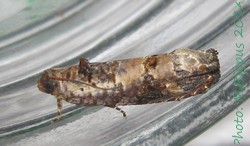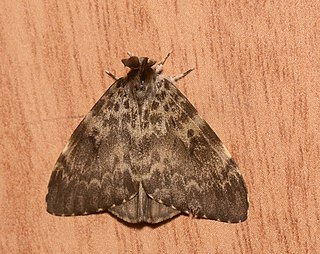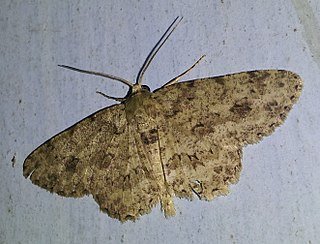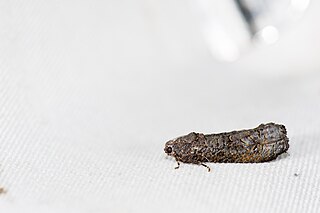
Cryptophlebia ombrodelta, the litchi fruit moth or macadamia nut borer, is a moth of the family Tortricidae. The species was first described by Oswald Bertram Lower in 1898. It is native to India, Sri Lanka, Nepal, Indonesia, China, Taiwan, Vietnam, Thailand, western Malaysia, New Guinea, the Philippines, Japan, Guam, the Caroline Islands, Australia and has been introduced to Hawaii.

Bactra venosana, the nutgrass borer or nutsedge borer, is a moth of the family Tortricidae. It was first described by Philipp Christoph Zeller in 1847. Julius von Kennel provides a full description. It has a wide distribution, from southern Europe, North Africa and Asia Minor to India, Sri Lanka, southern China, Malaya, Australia and into the Pacific where it is found on Java, Borneo, the Philippines, Taiwan, Timor, the Solomons, the Carolines and Fiji. It was introduced to Hawaii in 1925 to control nutsedge. It is now found on Kauai, Oahu, Molokai, Maui, Lanai and Hawaii.

Dudua aprobola, the mango flower webworm or litchi leaf roller, is a moth of the family Tortricidae. The species was first described by Edward Meyrick in 1886. It is a pest on several economically important crops.

Biston suppressaria, the tea looper, is a moth of the family Geometridae. It is found in China, India, Myanmar, Nepal, and Sri Lanka.

Homona coffearia, the tea tortrix or camellia tortrix, is a moth of the family Tortricidae. The species was first described by Nietner in 1861. It is widely distributed in the Oriental region.
Syntozyga ephippias is a tortrix moth, belonging to tribe Eucosmini of subfamily Olethreutinae. The species was first described by Edward Meyrick in 1907. It is found Sri Lanka, India, the Democratic Republic of the Congo, South Africa and Rodrigues.
Hilarographa caminodes is a species of moth of the family Tortricidae first described by Edward Meyrick in 1905. It is found in Sri Lanka and India.
Planostocha cumulata is a species of moth of the family Tortricidae first described by Edward Meyrick in 1907. It has a wide distribution, ranging from India, Sri Lanka, Nepal, Myanmar, Korea, Thailand, Brunei and New Guinea to Queensland in Australia. The habitat consists of lowland to montane areas.
Strepsicrates rhothia is a species of moth of the family Tortricidae first described by Edward Meyrick in 1910. It is found in Taiwan, Sri Lanka, India, the Democratic Republic of the Congo, Ghana, Madagascar, Mauritius and South Africa.

Lymantria ampla is a moth of the family Erebidae first described by Francis Walker in 1855. It is found in India and Sri Lanka.

Ectropis bhurmitra, the tea twig caterpillar, is a moth of the family Geometridae. The species was first described by Francis Walker in 1860. A widespread Asian species, it is found around Indo-Australian tropics from India, Sri Lanka and Hong Kong, Taiwan, Thailand, New Guinea to Australian Queensland and the Solomon Islands.
Phycita clientella, the brinjal leaf-folding caterpillar, is a moth of the family Pyralidae. The species was first described by Philipp Christoph Zeller in 1867. It is found in India, western Malaysia, Sri Lanka, Nicobar Islands and the Andaman Islands.
Naranga diffusa, the rice green semilooper, is a moth of the family Noctuidae. The species was first described by Francis Walker in 1865. It is found in many agricultural based countries such as Bangladesh, India, Sri Lanka, China, Hong Kong, Iran, Japan, the Korean Peninsula, Malaysia, Myanmar, the Philippines, Thailand, Taiwan and Vietnam.
Wegneria lachanitis is a moth of the family Tineidae first described by Edward Meyrick in 1906. It is found in Sri Lanka and India.
Macroplectra nararia, the coconut slug caterpillar, is a moth of the family Limacodidae. The species was first described by Frederic Moore in 1859. It is found in Sri Lanka and India.

Parasa bicolor, the green rice moth, is a moth of the family Limacodidae. The species was first described by Francis Walker in 1855. It is found in Sri Lanka, India, Nepal, Pakistan, Myanmar, Laos, Taiwan, Vietnam, Malaysia, Java, China and Taiwan.
Herpystis jejuna is a moth of the family Tortricidae first described by Edward Meyrick in 1916. It is found in India, Sri Lanka, and Fiji.

Arcesis threnodes is a moth of the family Tortricidae first described by Edward Meyrick in 1905. It is found in India, Sri Lanka and Taiwan.
Tetramoera isogramma is a moth of the family Tortricidae first described by Edward Meyrick in 1908. It is found in Sri Lanka, Malaysia, Hong Kong, Réunion and Africa.
Lasiognatha mormopa is a moth of the family Tortricidae first described by Edward Meyrick in 1906. It is found in India, Sri Lanka, Borneo and the Philippines.








